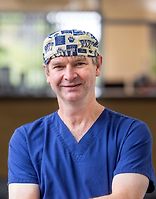Southland > Private Hospitals & Specialists > Southern Cross Hospitals >
Southern Cross Invercargill Hospital - Gynaecology
Private Surgical Service, Gynaecology
Description
Southern Cross' Invercargill hospital was originally established in 1919. It was bequeathed to Southern Cross in 1992 - and a new hospital was built and completed in August 1994.
The hospital is a top class facility in a very pleasant inner city location, situated opposite Queens Park.
Our hospital offers patients quality care and features comfortable patient rooms with pleasant surroundings and close by cafes for family and support people to access.
Our promise is a quality-driven and friendly service and we offer our patients excellent, modern facilities, and access to a range of elective surgical and specialist services including general surgery, gynaecological surgery, breast surgery, oral and maxillofacial surgery, orthopaedic surgery, otolaryngology, gastroenterology and endoscopy services, urology and vascular surgery.
Consultants
-

Mr Richard Dover
Gynaecologist
-

Mr Jim Faherty
Gynaecologist
-

Mr Simon Jones
Gynaecologist
-

Mr Benjamin Sharp
Gynaecologist
-

Mr John Short
Gynaecologist
-

Mr Michael Stitely
Gynaecologist
-

Dr Kate Van Harselaar
Gynaecologist
Procedures / Treatments
Lletz (Large Loop Excision of the Transformation Zone) A thin wire loop that has an electrical current running through it is used to scrape abnormal cells from the cervix. Laser Treatment of the Cervix A laser beam (high energy light) is used to destroy abnormal cells of the cervix. Cone Biopsy of the Cervix A cone of tissue is surgically removed from the cervix for examination in the laboratory.
Lletz (Large Loop Excision of the Transformation Zone) A thin wire loop that has an electrical current running through it is used to scrape abnormal cells from the cervix. Laser Treatment of the Cervix A laser beam (high energy light) is used to destroy abnormal cells of the cervix. Cone Biopsy of the Cervix A cone of tissue is surgically removed from the cervix for examination in the laboratory.
Lletz (Large Loop Excision of the Transformation Zone)
A thin wire loop that has an electrical current running through it is used to scrape abnormal cells from the cervix.
Laser Treatment of the Cervix
A laser beam (high energy light) is used to destroy abnormal cells of the cervix.
Cone Biopsy of the Cervix
A cone of tissue is surgically removed from the cervix for examination in the laboratory.
A colposcopy is a detailed examination of the cervix (entrance to the uterus) with a specially lit microscope (colposcope). As with a cervical smear, an instrument called a speculum is inserted into the vagina, and then the colposcope is inserted with its light directed on the cervix. A specialist will perform a colposcopy if your cervical smear has shown abnormal or cancerous cells on the cervix. During the colposcopy further samples of tissue (biopsies) are usually removed and examined in the laboratory so the doctor can get a clearer idea of the extent of the abnormal cells.
A colposcopy is a detailed examination of the cervix (entrance to the uterus) with a specially lit microscope (colposcope). As with a cervical smear, an instrument called a speculum is inserted into the vagina, and then the colposcope is inserted with its light directed on the cervix. A specialist will perform a colposcopy if your cervical smear has shown abnormal or cancerous cells on the cervix. During the colposcopy further samples of tissue (biopsies) are usually removed and examined in the laboratory so the doctor can get a clearer idea of the extent of the abnormal cells.
A colposcopy is a detailed examination of the cervix (entrance to the uterus) with a specially lit microscope (colposcope). As with a cervical smear, an instrument called a speculum is inserted into the vagina, and then the colposcope is inserted with its light directed on the cervix.
A specialist will perform a colposcopy if your cervical smear has shown abnormal or cancerous cells on the cervix. During the colposcopy further samples of tissue (biopsies) are usually removed and examined in the laboratory so the doctor can get a clearer idea of the extent of the abnormal cells.
Incisions (cuts) are made in the abdomen (stomach) to allow access to your bladder. The vagina is lifted and attached to the pelvis wall, allowing the bladder neck to be supported, thus correcting urine leakage.
Incisions (cuts) are made in the abdomen (stomach) to allow access to your bladder. The vagina is lifted and attached to the pelvis wall, allowing the bladder neck to be supported, thus correcting urine leakage.
Incisions (cuts) are made in the abdomen (stomach) to allow access to your bladder. The vagina is lifted and attached to the pelvis wall, allowing the bladder neck to be supported, thus correcting urine leakage.
A long, thin tube with a tiny camera attached (cytoscope) is inserted into the urinary opening and through your urethra (the tube that carries urine from your bladder to the outside of your body) to your bladder. This allows the urologist to view any abnormalities in your lower urinary tract and, if necessary, take a small tissue sample to look at under the microscope (biopsy).
A long, thin tube with a tiny camera attached (cytoscope) is inserted into the urinary opening and through your urethra (the tube that carries urine from your bladder to the outside of your body) to your bladder. This allows the urologist to view any abnormalities in your lower urinary tract and, if necessary, take a small tissue sample to look at under the microscope (biopsy).
A long, thin tube with a tiny camera attached (cytoscope) is inserted into the urinary opening and through your urethra (the tube that carries urine from your bladder to the outside of your body) to your bladder. This allows the urologist to view any abnormalities in your lower urinary tract and, if necessary, take a small tissue sample to look at under the microscope (biopsy).
Metal dilators are inserted through your vagina and used to widen the opening to the uterus. A curette (an instrument with a flat metal loop at one end) is then used to scrape the lining of the uterus.
Metal dilators are inserted through your vagina and used to widen the opening to the uterus. A curette (an instrument with a flat metal loop at one end) is then used to scrape the lining of the uterus.
Metal dilators are inserted through your vagina and used to widen the opening to the uterus. A curette (an instrument with a flat metal loop at one end) is then used to scrape the lining of the uterus.
Laparoscopic: an incision (cut) is made near your navel (tummy button) and a thin tube with a tiny camera attached (laparoscope) is inserted, allowing the surgeon a view of the internal organs. If endometriosis is being treated, small instruments are introduced through several small cuts in the lower abdomen and endometrial tissue is destroyed using an electric current or laser beam. Abdominal (laparotomy): if endometriosis is very widespread, an incision is made in the abdomen, opening up the abdominal cavity so that the endometrial tissue can be removed.
Laparoscopic: an incision (cut) is made near your navel (tummy button) and a thin tube with a tiny camera attached (laparoscope) is inserted, allowing the surgeon a view of the internal organs. If endometriosis is being treated, small instruments are introduced through several small cuts in the lower abdomen and endometrial tissue is destroyed using an electric current or laser beam. Abdominal (laparotomy): if endometriosis is very widespread, an incision is made in the abdomen, opening up the abdominal cavity so that the endometrial tissue can be removed.
Laparoscopic: an incision (cut) is made near your navel (tummy button) and a thin tube with a tiny camera attached (laparoscope) is inserted, allowing the surgeon a view of the internal organs. If endometriosis is being treated, small instruments are introduced through several small cuts in the lower abdomen and endometrial tissue is destroyed using an electric current or laser beam.
Abdominal (laparotomy): if endometriosis is very widespread, an incision is made in the abdomen, opening up the abdominal cavity so that the endometrial tissue can be removed.
Abdominal: an incision (cut) is made in your the abdomen (stomach) and the uterus removed. Vaginal: an incision is made in your vagina and the uterus removed through the vagina. Laparoscopic: several small incisions are made in your abdomen and a thin tube with a tiny camera attached (laparoscope) inserted along with instruments that cut the connections of the uterus, allowing it to be removed through the vagina.
Abdominal: an incision (cut) is made in your the abdomen (stomach) and the uterus removed. Vaginal: an incision is made in your vagina and the uterus removed through the vagina. Laparoscopic: several small incisions are made in your abdomen and a thin tube with a tiny camera attached (laparoscope) inserted along with instruments that cut the connections of the uterus, allowing it to be removed through the vagina.
Abdominal: an incision (cut) is made in your the abdomen (stomach) and the uterus removed.
Vaginal: an incision is made in your vagina and the uterus removed through the vagina.
Laparoscopic: several small incisions are made in your abdomen and a thin tube with a tiny camera attached (laparoscope) inserted along with instruments that cut the connections of the uterus, allowing it to be removed through the vagina.
A speculum is inserted into your vagina, as for a cervical smear, and a long, thin tube with a tiny camera attached (hysteroscope) is placed into the vagina and moved through into the uterus. This allows the surgeon to see inside the uterus and may, in some cases, show the reason for conditions such as infertility or pelvic pain. A hysteroscope may also be used to remove fibroids or polyps or to take a biopsy (small sample of tissue) for examination in the laboratory.
A speculum is inserted into your vagina, as for a cervical smear, and a long, thin tube with a tiny camera attached (hysteroscope) is placed into the vagina and moved through into the uterus. This allows the surgeon to see inside the uterus and may, in some cases, show the reason for conditions such as infertility or pelvic pain. A hysteroscope may also be used to remove fibroids or polyps or to take a biopsy (small sample of tissue) for examination in the laboratory.
A speculum is inserted into your vagina, as for a cervical smear, and a long, thin tube with a tiny camera attached (hysteroscope) is placed into the vagina and moved through into the uterus. This allows the surgeon to see inside the uterus and may, in some cases, show the reason for conditions such as infertility or pelvic pain. A hysteroscope may also be used to remove fibroids or polyps or to take a biopsy (small sample of tissue) for examination in the laboratory.
Anterior: an incision (cut) is made in your navel (tummy button) and several small cuts in the abdomen (stomach). A thin telescopic instrument (laparoscope) and several small instruments are inserted into the cuts and used to tighten up the front wall of the vagina to repair a cystocele (bulging of the bladder into the vaginal wall). Posterior: an incision is made in your navel and several small cuts in the abdomen. A laparoscope and several small instruments are inserted into the cuts and used to tighten up the back wall of the vagina to repair a rectocele (bulging of the rectum into the vaginal wall).
Anterior: an incision (cut) is made in your navel (tummy button) and several small cuts in the abdomen (stomach). A thin telescopic instrument (laparoscope) and several small instruments are inserted into the cuts and used to tighten up the front wall of the vagina to repair a cystocele (bulging of the bladder into the vaginal wall). Posterior: an incision is made in your navel and several small cuts in the abdomen. A laparoscope and several small instruments are inserted into the cuts and used to tighten up the back wall of the vagina to repair a rectocele (bulging of the rectum into the vaginal wall).
Anterior: an incision (cut) is made in your navel (tummy button) and several small cuts in the abdomen (stomach). A thin telescopic instrument (laparoscope) and several small instruments are inserted into the cuts and used to tighten up the front wall of the vagina to repair a cystocele (bulging of the bladder into the vaginal wall).
Posterior: an incision is made in your navel and several small cuts in the abdomen. A laparoscope and several small instruments are inserted into the cuts and used to tighten up the back wall of the vagina to repair a rectocele (bulging of the rectum into the vaginal wall).
Laparoscopic: an incision (cut) is made in your navel (tummy button) and several small cuts in the abdomen (stomach). A thin telescopic instrument (laparoscope) and several small instruments are inserted into the cuts and moved through into the uterus allowing the surgeon to view the fibroids. Small fibroids can then be removed either by introducing small surgical tools to cut them away or by vaporising them with a laser or electric current. For large fibroids, an incision is made across your abdomen and the fibroids are cut out of the uterus. Hysteroscopic: a speculum is inserted into your vagina, as for a pap smear, and a long, thin tube with a tiny camera attached (hysteroscope) is placed into the vagina and moved through into the uterus. This allows the surgeon to see inside the uterus and remove the fibroids.
Laparoscopic: an incision (cut) is made in your navel (tummy button) and several small cuts in the abdomen (stomach). A thin telescopic instrument (laparoscope) and several small instruments are inserted into the cuts and moved through into the uterus allowing the surgeon to view the fibroids. Small fibroids can then be removed either by introducing small surgical tools to cut them away or by vaporising them with a laser or electric current. For large fibroids, an incision is made across your abdomen and the fibroids are cut out of the uterus. Hysteroscopic: a speculum is inserted into your vagina, as for a pap smear, and a long, thin tube with a tiny camera attached (hysteroscope) is placed into the vagina and moved through into the uterus. This allows the surgeon to see inside the uterus and remove the fibroids.
Laparoscopic: an incision (cut) is made in your navel (tummy button) and several small cuts in the abdomen (stomach). A thin telescopic instrument (laparoscope) and several small instruments are inserted into the cuts and moved through into the uterus allowing the surgeon to view the fibroids. Small fibroids can then be removed either by introducing small surgical tools to cut them away or by vaporising them with a laser or electric current. For large fibroids, an incision is made across your abdomen and the fibroids are cut out of the uterus.
Hysteroscopic: a speculum is inserted into your vagina, as for a pap smear, and a long, thin tube with a tiny camera attached (hysteroscope) is placed into the vagina and moved through into the uterus. This allows the surgeon to see inside the uterus and remove the fibroids.
Laparascopic: several small incisions (cuts) are made in your abdomen (stomach) and a thin tube with a tiny camera attached (laparoscope) inserted, allowing the surgeon a view of the ovaries. Small surgical instruments are introduced through the other cuts and are used to remove the ovary and tie off the fallopian tube. Abdominal: an incision is made in the abdomen, the ovary is surgically removed and the fallopian tube tied off.
Laparascopic: several small incisions (cuts) are made in your abdomen (stomach) and a thin tube with a tiny camera attached (laparoscope) inserted, allowing the surgeon a view of the ovaries. Small surgical instruments are introduced through the other cuts and are used to remove the ovary and tie off the fallopian tube. Abdominal: an incision is made in the abdomen, the ovary is surgically removed and the fallopian tube tied off.
Laparascopic: several small incisions (cuts) are made in your abdomen (stomach) and a thin tube with a tiny camera attached (laparoscope) inserted, allowing the surgeon a view of the ovaries. Small surgical instruments are introduced through the other cuts and are used to remove the ovary and tie off the fallopian tube.
Abdominal: an incision is made in the abdomen, the ovary is surgically removed and the fallopian tube tied off.
Several small incisions (cuts) are made in your abdomen (stomach) and a thin tube with a tiny camera attached (laparoscope) inserted, allowing the surgeon a view of your ovaries. Small instruments are inserted through the cuts and into the ovaries, where they remove the cysts.
Several small incisions (cuts) are made in your abdomen (stomach) and a thin tube with a tiny camera attached (laparoscope) inserted, allowing the surgeon a view of your ovaries. Small instruments are inserted through the cuts and into the ovaries, where they remove the cysts.
Several small incisions (cuts) are made in your abdomen (stomach) and a thin tube with a tiny camera attached (laparoscope) inserted, allowing the surgeon a view of your ovaries. Small instruments are inserted through the cuts and into the ovaries, where they remove the cysts.
An incision (cut) is made in your navel (tummy button) and several small cuts in the abdomen (stomach). A thin telescopic instrument (laparoscope) is inserted through your navel, allowing the surgeon a view of the pelvic floor. Small instruments are inserted into the cuts that can lift the prolapsed or sagging organs back into position and reattach them.
An incision (cut) is made in your navel (tummy button) and several small cuts in the abdomen (stomach). A thin telescopic instrument (laparoscope) is inserted through your navel, allowing the surgeon a view of the pelvic floor. Small instruments are inserted into the cuts that can lift the prolapsed or sagging organs back into position and reattach them.
An incision (cut) is made in your navel (tummy button) and several small cuts in the abdomen (stomach). A thin telescopic instrument (laparoscope) is inserted through your navel, allowing the surgeon a view of the pelvic floor. Small instruments are inserted into the cuts that can lift the prolapsed or sagging organs back into position and reattach them.
Laparoscopic: several small incisions (cuts) are made in your abdomen (stomach) and a thin tube with a tiny camera attached (laparoscope) inserted, allowing the surgeon a view of your fallopian tubes. Small surgical instruments are introduced through the other cuts and are used to remove part or all of the fallopian tube. Abdominal (laparotomy): an incision is made in your abdomen and part or all of the fallopian tube is removed.
Laparoscopic: several small incisions (cuts) are made in your abdomen (stomach) and a thin tube with a tiny camera attached (laparoscope) inserted, allowing the surgeon a view of your fallopian tubes. Small surgical instruments are introduced through the other cuts and are used to remove part or all of the fallopian tube. Abdominal (laparotomy): an incision is made in your abdomen and part or all of the fallopian tube is removed.
Laparoscopic: several small incisions (cuts) are made in your abdomen (stomach) and a thin tube with a tiny camera attached (laparoscope) inserted, allowing the surgeon a view of your fallopian tubes. Small surgical instruments are introduced through the other cuts and are used to remove part or all of the fallopian tube.
Abdominal (laparotomy): an incision is made in your abdomen and part or all of the fallopian tube is removed.
A sample of tissue (biopsy) is surgically removed from a lesion (area of damaged tissue) on your vulva. If the lesion is cut out completely, the procedure is called an excision.
A sample of tissue (biopsy) is surgically removed from a lesion (area of damaged tissue) on your vulva. If the lesion is cut out completely, the procedure is called an excision.
A sample of tissue (biopsy) is surgically removed from a lesion (area of damaged tissue) on your vulva. If the lesion is cut out completely, the procedure is called an excision.
Visiting Hours
Weekdays 8:00 to 20:00
Weekends 8:00 to 20:00
Public Transport
The Invercargill City Council provides good public transport information. See here
Parking
Over 20 parking spaces are provided for patients and visitors.
Pharmacy
Contact Details
Southern Cross Invercargill Hospital
Southland
-
Phone
(03) 211 2260
-
Fax
(03) 211 2261
Email
Website
108 Deveron Street
Invercargill
Southland 9810
Street Address
108 Deveron Street
Invercargill
Southland 9810
Postal Address
PO Box 1502
Invercargill 9840
Was this page helpful?
This page was last updated at 11:08AM on April 11, 2025. This information is reviewed and edited by Southern Cross Invercargill Hospital - Gynaecology.

